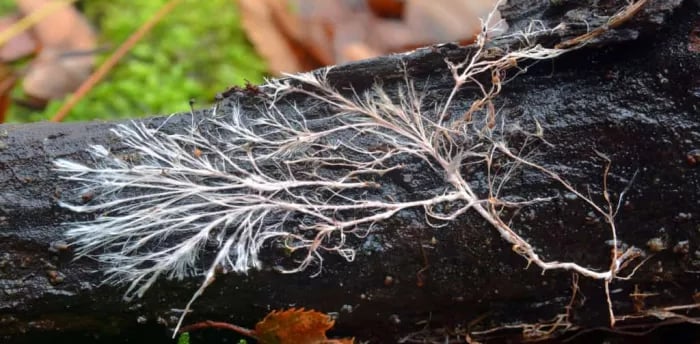The Underground Gardeners: Why Living Soil Matters More Than You Think
Discover the hidden life beneath your garden beds. This post explores how weed fabric disrupts the vital mycorrhizal networks that support plant health—and what you can do instead to nurture living, breathable soil in your shade garden.
SOIL HEALTH & GARDEN FOUNDATIONS
Marcus Bergin
5/22/20253 min read


There’s something quietly miraculous happening just beneath our feet. While we fuss over foliage and blooms, the real work of the garden is taking place underground—unseen, mostly uncelebrated, but absolutely essential.
In our Facebook group, we recently discussed the pitfalls of weed fabric. That post sparked a wave of responses, many of which touched on a fascinating and often overlooked truth: that a garden's health doesn’t start above ground—it starts below. And if we get that part right, the rest often follows.
So today, let’s peel back the layers—quite literally—and dig into what’s happening beneath the mulch, how weed fabric disrupts it, and why embracing the living soil is one of the most powerful choices a gardener can make.
What Is the Mycorrhizal Network?
Under every thriving garden lies a hidden ecosystem known as the mycorrhizal network. The name comes from the Greek mykes (fungus) and rhiza (root), and it's exactly that—a symbiotic partnership between fungi and plant roots.
Mycorrhizal fungi colonise plant roots and extend far into the soil through microscopic filaments called hyphae.
These hyphae vastly increase a plant's reach—allowing it to access water and nutrients (especially phosphorus) well beyond its root zone.
In exchange, the plant provides the fungi with sugars produced through photosynthesis.
This relationship is so fundamental that around 90% of all land plants form mycorrhizal partnerships. Without them, many plants—particularly those in woodland and shade environments—struggle to establish and thrive.
The “Wood Wide Web” and Its Remarkable Abilities
Coined by scientist Suzanne Simard, the term Wood Wide Web refers to the ability of mycorrhizal fungi to link plants together in a shared underground network.
This network has been shown to:
Transfer nutrients from well-established trees to younger or struggling plants.
Send chemical warnings if one part of the system is under attack from pests or pathogens.
Improve drought resilience, nutrient uptake, and soil structure.
Studies in temperate forests have demonstrated that older trees can funnel carbon to shaded understory saplings through these fungal pathways, helping them survive in low light. In effect, the soil becomes an intelligent, cooperative system—not just a substrate.
What Weed Fabric Gets in the Way Of
Weed-suppressing fabrics—often made of synthetic polypropylene—are laid down with good intentions. But in practice, they:
Block air and water movement into the topsoil.
Prevent organic material from decomposing into the soil, cutting off a key food source for soil life.
Starve the mycorrhizal fungi of the litter layer they need to flourish.
Eventually get covered with soil and debris, where weeds still grow—this time with roots anchored in a mess that’s harder to manage.
One study published in HortTechnology (2007) found that fabric mulch significantly reduced soil microbial biomass and enzyme activity compared to organic mulches like bark or leaf mould.
And when it comes time to plant? Cutting through the fabric disrupts any structure that has formed, damages fungal strands, and exposes weed seeds to light—inviting exactly what you were trying to avoid.
What to Do Instead: Working With the Soil
A living garden starts with living soil. Here’s how to support it:
1. Mulch Generously—but with the Right Materials
Use organic mulch: compost, bark, leaf mould, straw, wood chips. These slowly decompose, feeding fungi and microbes. Aim for 2–3 inches, topped up seasonally.
2. Plant Densely and Diversely
Varied root systems encourage different microbial relationships. In shady beds, try combinations like ferns, epimediums, heucheras, and native woodlanders.
3. Disturb the Soil as Little as Possible
Avoid deep digging. If you need to amend the soil, do so from above with top-dressing. Think “no-dig” rather than double-dig.
4. Avoid Harsh Chemicals
Many fungicides, pesticides, and synthetic fertilisers harm or kill beneficial fungi. Organic alternatives and gentle practices help maintain balance.
5. Add Mycorrhizal Inoculants (When Appropriate)
Especially useful when planting trees, roses, or shrubs into previously disturbed soil. These contain spores of beneficial fungi that help kickstart underground relationships.
Beyond the Roots: What This Means for Shade Gardens
Shade gardens often rely on layered planting and soil health to succeed. You’re already working with lower light—so giving your plants access to a strong underground network makes all the difference.
In USDA Zones 5–8 (and RHS Zones H4–H7), this is especially important. Cooler, moisture-retentive soils offer ideal fungal conditions—if we allow them to breathe and feed.
Final Thoughts: Trusting the Soil to Do Its Job
Gardening is often painted as a top-down process—we plan, we plant, we prune. But when we shift our thinking and start from below, something magical happens.
Remove the fabric. Let in the breath of rain and the rustle of leaf litter. Lay down mulch that will quietly melt into the soil. Then stand back and watch how the garden responds—not just above ground, but deep within.
Because beneath every healthy plant is a community—an ancient, generous one—just waiting to be heard.